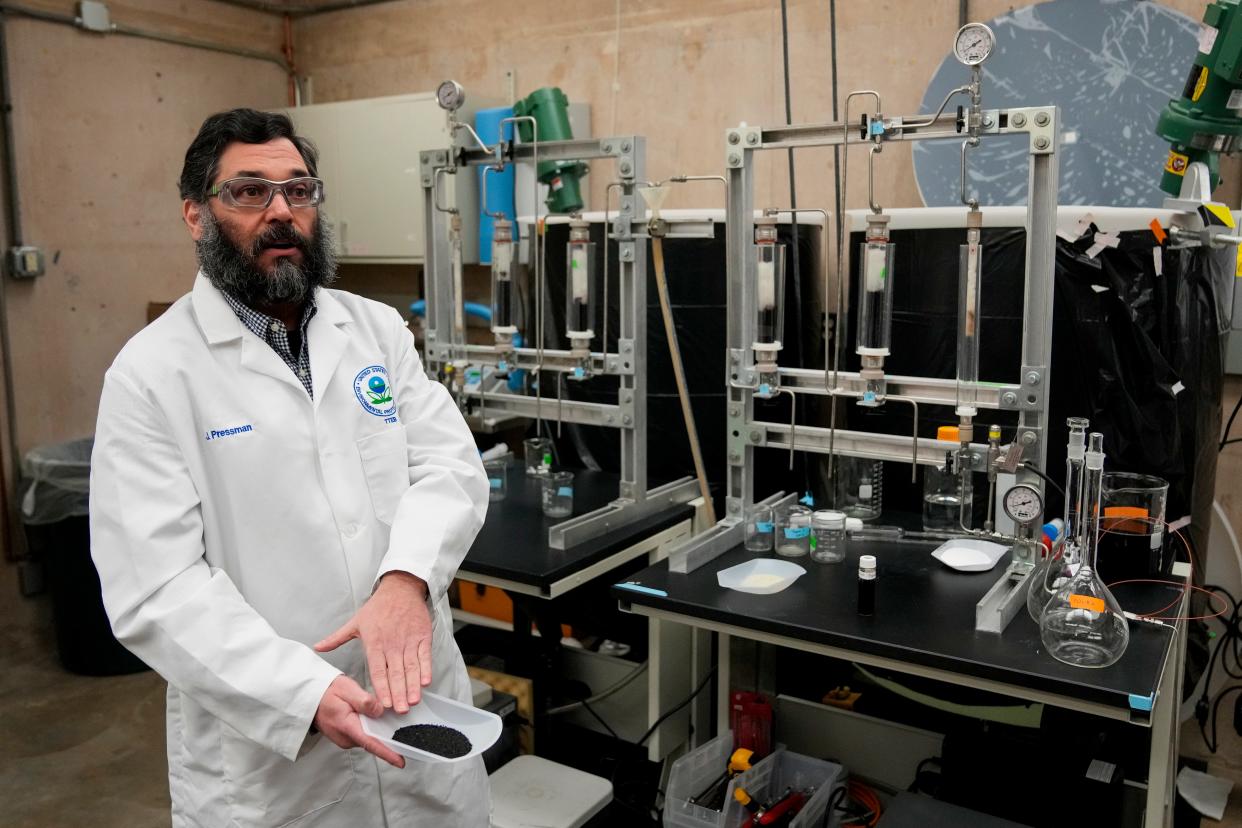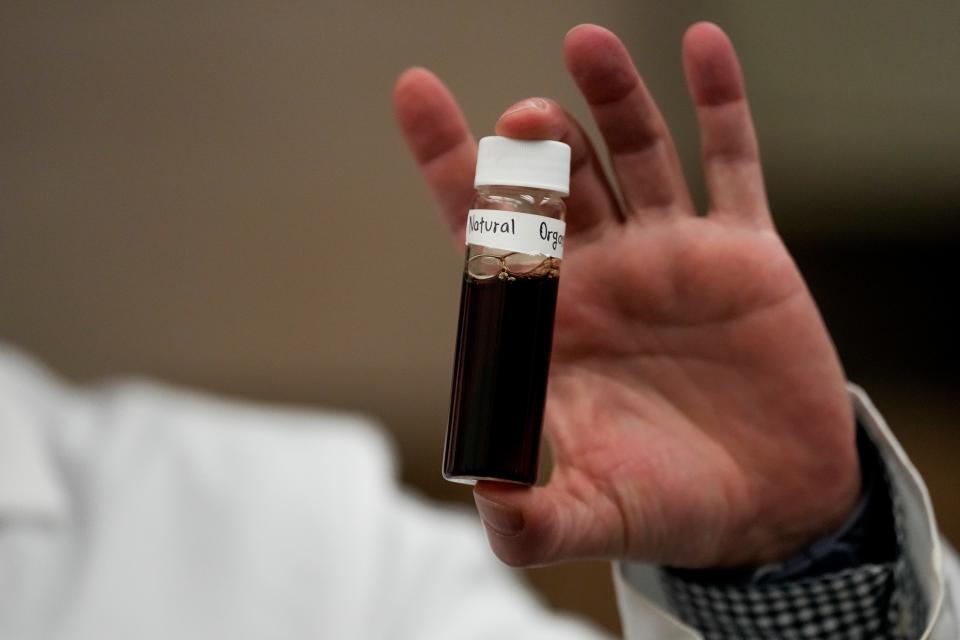Federal government's long-awaited standards for 'forever chemicals' in drinking water are set lower than Wisconsin's limits

MADISON – The Environmental Protection Agency on Tuesday signaled it would be setting standards for two of the most well-known forever chemicals well below those established by Wisconsin last summer.
The agency released a draft of its proposed rules for two common chemicals in the PFAS family of compounds — PFOA and PFOS — at a limit of 4 parts per trillion in drinking water, according to a pre-publication notice from the agency.
“Communities across this country have suffered far too long from the ever-present threat of PFAS pollution. That’s why President Biden launched a whole-of-government approach to aggressively confront these harmful chemicals, and EPA is leading the way forward,” EPA Administrator Michael Regan said in a statement.
“EPA’s proposal to establish a national standard for PFAS in drinking water is informed by the best available science and would help provide states with the guidance they need to make decisions that best protect their communities. This action has the potential to prevent tens of thousands of PFAS-related illnesses and marks a major step toward safeguarding all our communities from these dangerous contaminants.”
The agency also proposed a regulation to limit any mixture containing one or more of PFNA, PFHxS, PFBS, and/or GenX Chemicals, according to the document. For these PFAS, water systems would use an established approach called a hazard index calculation, defined in the proposed rule, to determine if the combined levels of these PFAS pose a potential risk.
The rules were cleared last week by the Biden administration, the last necessary step before their public disclosure. If approved, the rules will require all public water systems to test for the listed compounds and notify the public if levels exceed the standard.
Wisconsin already requires testing for all public water systems and recommends that any system found to have PFAS at any level should notify water users.
Last year, the EPA set health action limits for PFOA and PFOS, setting the "safe" amount of the compounds for humans to consume at incredibly low levels: 0.004 parts per trillion for PFOA and 0.02 parts per trillion for PFOS. The new federal recommendations for PFOA and PFOS were created based on human studies in populations exposed to the compounds. PFOA and PFOS are two of the most well-known and well-researched compounds in the PFAS family.
By contrast, Wisconsin implemented standards for drinking water at 70 parts per trillion for PFOA and PFOS last year. Those limits matched the federal guidance put in place in 2016, but hadn't been updated to reflect the emerging science.
The state doesn't have regulations for groundwater, but the Department of Natural Resources this year began the three-year rulemaking process to establish those. Standards were proposed previously but were voted down by the Natural Resources Board in early 2022 after a disagreement over what level of PFAS should be permitted.
The DNR Tuesday acknowledged the EPA's new recommendations in an email.
Wisconsin’s Department of Natural Resources (DNR) and Department of Health Services (DHS) recognize the need to assess risks to human health from mixtures of PFAS and appreciate the steps EPA has taken here," the email said. "Both agencies will review the proposed standards and accompanying documents and monitor the federal rulemaking process as the EPA works toward a final rule."
PFAS — or per- and polyfluoroalkyl substances — are a family of man-made chemicals used for their water- and stain-resistant qualities in products like clothing and carpet, nonstick cookware, packaging and firefighting foam. The family includes 5,000 compounds, which are persistent, remaining both in the environment and the human body over time.
The chemicals have been linked to types of kidney and testicular cancers, lower birth weights, harm to immune and reproductive systems, altered hormone regulation and altered thyroid hormones. The chemicals enter the human body largely through drinking water.
The compounds have been found in a number of Wisconsin communities over the last several years, including Marinette, Peshtigo, Wausau, Eau Claire, Milwaukee, Madison, La Crosse and Mosinee.
A Journal Sentinel investigation last year found a number of smaller water supplies are being impacted by the chemicals as well, including some cities, such as Palmyra, that had PFOA above the new recommendations.
Environmental groups applaud rules
Groups that have continuously pushed the Biden administration to take action on PFAS are celebrating the release of the rules as a big stride forward on tackling contamination.
“Today’s announcement by the EPA is historic progress,” Scott Faber, senior vice president for government affairs at the Environmental Working Group, said in a press release. “More than 200 million Americans could have PFAS in their tap water. Americans have been drinking contaminated water for decades. This proposal is a critical step toward getting these toxic poisons out of our water."
The Great Lakes PFAS Action Network also released a statement of support.
“The EPA’s proposed drinking water standards are an important milestone in the fight to protect public health and will save lives in impacted communities on the front lines of the PFAS crisis,” co-chair Tony Spaniola said. “This is an A+ decision by the Biden Administration for front-line communities. We urge that the proposed drinking water standards be adopted and implemented with all deliberate speed.”
But not all groups are satisfied.
The American Chemistry Council acknowledged it supports the development of drinking water standards, but said there are concerns with how the EPA established the limits released Tuesday.
“The EPA’s misguided approach to these MCLs is important, as these low limits will likely result in billions of dollars in compliance costs," the organization said in a statement referring to the EPA's Maximum Containment Levels. "The proposals have important implications for broader drinking water policy priorities and resources, so it’s critical that EPA gets the science right."
Low numbers raise concerns over how communities will treat water

Some Wisconsin communities are already preparing to confront PFAS contamination in their drinking water, but the cost of treating water for the compounds over a long period of time is a concern.
In Wausau, which has levels at 20 parts per trillion or higher in all of its municipal wells, the city is preparing to spend about $16 million to put in a granulated activated carbon system to filter all of its drinking water before it's piped to customers. The system will likely result in a rate increase for Wausau users.
"There are concerns with cost for smaller communities who might not have the financial means to put in treatment systems," said Carsten Prasse, an assistant professor of environmental health and engineering at John Hopkins University. "That's something that needs to be figured out, and we're going to need support from the federal side."
Prasse said that along with carbon filtration, ion exchange resin and reverse osmosis systems are solutions. The EPA is currently testing both mediums in its drinking water research and development lab in Cincinnati, trying to figure out how to best remove different compounds from water.
But while research is ongoing, there is concern over whether there is technology to deal with PFAS down to the levels the EPA is suggesting, Prasse said. In Wausau, the carbon system is estimated to remove the compounds down to 12 to 15 parts per trillion, which is still well above the new recommended regulations.
As for the removal of PFAS, there are no tried and true methods to destroy the compounds — only to concentrate them in order to remove them from water.
"I think it's great the EPA is doing something, but the general question is if we have the technologies to deal with them," he said. "To deal with this in the long run, we're going to have to prevent them (PFAS) from getting into the environment in the first place."
Check back for updates to this developing story.
Our subscribers make this reporting possible. Please consider supporting local journalism by subscribing to the Journal Sentinel at jsonline.com/deal.
DOWNLOAD THE APP: Get the latest news, sports and more
This article originally appeared on Milwaukee Journal Sentinel: EPA recommends PFAS drinking water limits lower than Wisconsin rules

